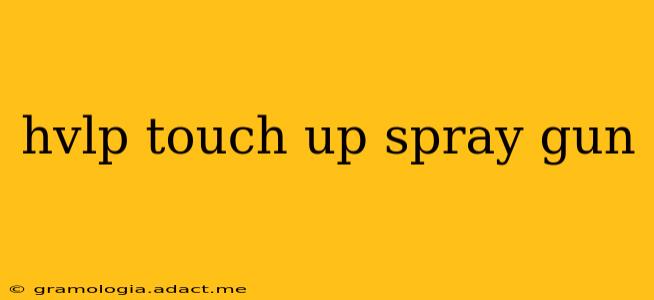Choosing the right HVLP (High Volume Low Pressure) touch-up spray gun can significantly improve the quality and efficiency of your paint projects, whether you're a professional or a DIY enthusiast. This guide dives deep into everything you need to know about these versatile tools, addressing common questions and concerns.
What is an HVLP Touch Up Spray Gun?
An HVLP touch-up spray gun is a specialized tool designed for applying small amounts of paint with precision and minimal overspray. Unlike conventional spray guns, HVLP systems use a high volume of air at low pressure to atomize the paint, resulting in a finer spray pattern and reduced material waste. This makes them ideal for touch-up work, intricate detailing, and projects requiring a smooth, even finish. The reduced overspray also contributes to a more environmentally friendly painting process.
What are the Benefits of Using an HVLP Touch Up Spray Gun?
Several advantages make HVLP touch-up spray guns a popular choice for various applications:
- Precise Application: The low-pressure air stream provides exceptional control, allowing for precise application of paint to small areas. This is crucial for touch-ups where you need to avoid affecting surrounding areas.
- Reduced Overspray: The significant reduction in overspray minimizes paint waste and cleanup, saving you both time and money. It also makes it a cleaner option for indoor use.
- Even Finish: The fine atomization of paint results in a smooth, even coat, reducing the likelihood of runs, drips, and orange peel effects.
- Versatility: Many HVLP touch-up spray guns are compatible with various types of paint, including lacquers, enamels, and primers.
- Ease of Use: While requiring some practice to master, HVLP guns are generally easier to use than other spray systems, particularly for beginners.
What Types of HVLP Touch Up Spray Guns are Available?
Several types of HVLP touch-up spray guns are available, differing primarily in size, features, and power source:
- Gravity Feed Guns: These guns hold the paint in a cup above the gun. They're generally suited for smaller projects and offer excellent control.
- Siphon Feed Guns: Paint is drawn from a reservoir below the gun. These are usually better for larger quantities of paint.
- Electric HVLP Spray Guns: These use an electric motor to power the air compressor, offering a convenient and portable option.
- Air-Powered HVLP Spray Guns: These require an external air compressor to function and generally offer more power and control than electric models.
How Do I Choose the Right HVLP Touch Up Spray Gun?
Selecting the right HVLP touch-up spray gun depends on your specific needs and preferences. Consider the following factors:
- Project Size and Scope: For small touch-up jobs, a smaller, gravity-fed gun may suffice. Larger projects might benefit from a siphon-feed or air-powered system.
- Paint Viscosity: Different paints require different spray settings. Ensure the gun's capabilities match the viscosity of your paint.
- Power Source: Electric guns are convenient, but air-powered systems usually offer more power and control.
- Budget: Prices vary significantly depending on the features and brand. Set a budget before you begin your search.
How to Use an HVLP Touch Up Spray Gun?
While specific instructions vary by model, here are some general tips for using an HVLP touch-up spray gun:
- Prepare the Surface: Properly clean and sand the surface to be painted for optimal adhesion.
- Thin the Paint (if necessary): Follow the manufacturer's instructions for thinning the paint to the appropriate viscosity for your gun.
- Practice: Before starting the main project, practice on a scrap piece of material to get a feel for the gun and its spray pattern.
- Maintain a Consistent Distance: Keep a consistent distance between the gun and the surface for an even finish.
- Overlapping Passes: Overlap each pass slightly to ensure complete coverage.
- Clean Thoroughly: Clean the gun immediately after use to prevent paint from clogging the nozzle.
What are the Common Problems with HVLP Touch Up Spray Guns?
Some common issues include clogging, inconsistent spray patterns, and poor atomization. These can often be resolved by ensuring proper cleaning, thinning the paint correctly, and checking the air pressure.
What is the Best HVLP Touch Up Spray Gun?
There's no single "best" HVLP touch-up spray gun, as the ideal choice depends on individual needs and preferences. Research different models and read reviews to find the one that best suits your requirements.
This guide provides a solid foundation for understanding HVLP touch-up spray guns. Remember to always consult the manufacturer's instructions for specific details on operation and maintenance. With a little practice and the right tools, you can achieve professional-looking results on all your touch-up projects.
